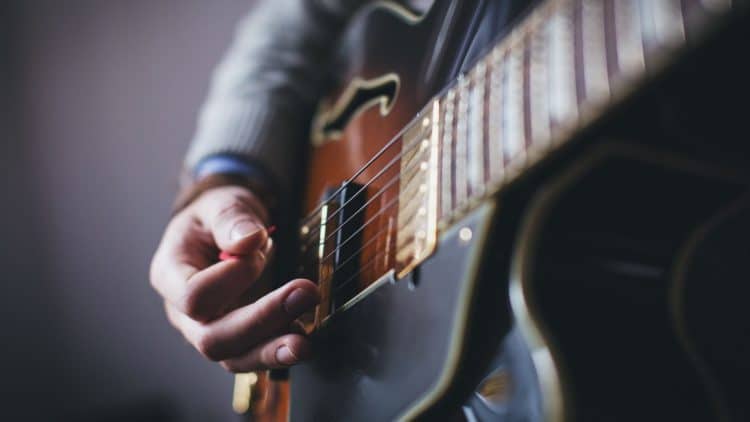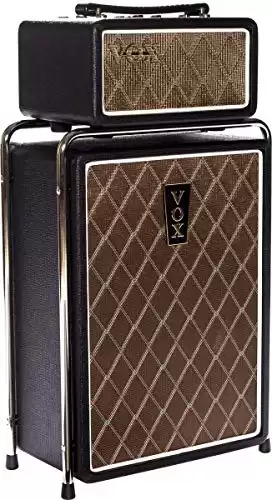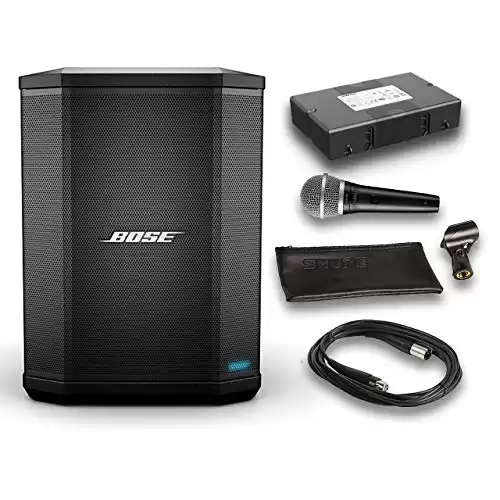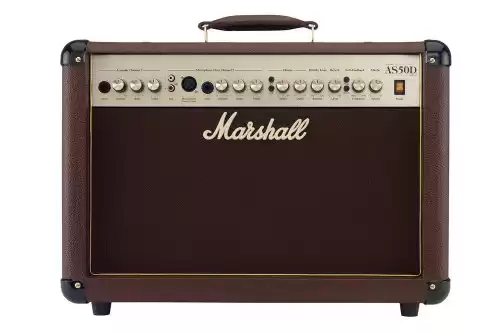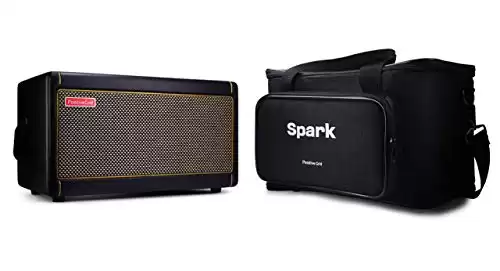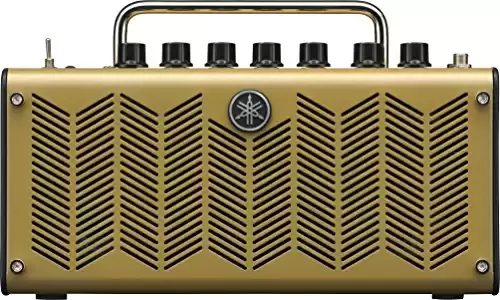Several guitar amps came out in the 1920s and 1930s as we learned more about what electronics and technology could provide. Although the Great Depression put a pause on American innovation at the time, a few great products were still released for consideration.
The Vivi-Tone amps from 1933 were often used for radio performances and live shows. When Rickenbacker released a combo amplifier in 1934 with metal corner protectors, it seemed like the music industry was ready to take a new leap into the future.
Since the 1990s, we’ve started looking back at our history. Although some modern mini amps don’t suck, they lose the vintage vibe that music fun to play in previous generations.
That’s why today’s best mini amps are often a few years old, have several effects, and even incorporate tubes.
12 Best Mini Guitar Amps in 2023
Most guitar amps sound their best when the volume levels are at 50% of maximum. If you never turn your current amplifier past three, you should grab something smaller. When you make sure the speakers are rated for the power the amp produces, you’ll hear your music play proudly.
That’s why you’ll want to review these fantastic mini amps for your collection. Your guitar might get heard in ways that you never thought was possible.
Read on to choose the best mini guitar amp for you:
- Vox Electric Guitar Mini Amp
- Fishman Loudbox Mini Guitar Amp 60W
- BOSS Katana MK-II 100w Combo Guitar Amp
- Amazon Basics Mini Acoustic Guitar Amplifier
- Fender Acoustic 100 Guitar Amplifier
- Roland CUBE Street EX Guitar Amplifier
- Bose S1 Pro Speaker System Bundle
- Marshall Acoustic Soloist AS50D Guitar Amp
- Orange Amps Electric Guitar Power Amplifier
- Positive Grid Spark Guitar Amplifier
- Yamaha THR5 Mini Acoustic Guitar Amplifier
- Fender Champion 40 Guitar Amp
1. Vox Electric Guitar Mini Amp
The Vox Electric Guitar Mini delivers a one-channel, 1×10-inch amplifier operating with 25 watts. The stack includes digital reverb with a headphone and line output option, tremolo, and a lightweight design that makes it easy to move.
You’ll get the iconic look of the Super Beetle with this product without compromising on the achievable audio. It’s the perfect addition to any home or practice space.
When you play the guitar, you can hear the amplifier tone in the headphones with the same clarity as the speaker.
It’s not loud enough for a gig unless you equip a mic to it, but you’ll find it well-suited for individual playing and practice needs.
The vibe is cool, slightly vintage, and the reverb alone will have you wanting to play it more.
2. Fishman Loudbox Mini 60W Guitar Amp
When you play the Fishman Loudbox Mini 60W guitar amp, you’re using the brand’s lightest and most portable design. It’s perfect for any electric acoustic, especially when you want clean and bright tones.
You’ll receive two channels with this unit, delivering the brand’s legendary preamp at an affordable price. It also supports a balanced XLR and comes with an AUX input.
You’ll get two channels: one for the instrument and the other for a microphone. Here are the other specs to consider with this mini amp.
| Power: | 60 watts when working with the master volume |
| Drivers: | 6.5-inch woofer paired with a one-inch soft dome tweeter |
| SPL: | 108 dB at one meter |
| Speaker Baffle: | 10-inch with a built-in tilt for added noise projection |
| Weight: | 19.7 pounds |
| Dimensions: | 12 x 13.7 x 9.7 inches (H, W, D) |
Although the color is a little off-putting with its beige and brown combination, that issue is easily fixed with a simple cover.
3. BOSS Katana MK-II 100w Combo Guitar Amp
Although the BOSS Katana MK-II 100W Combo Amp is a little bigger than most mini designs, you’ll appreciate the extra power and high-quality tones that come from this affordable unit.
It’s a stage-ready product that delivers bright, slightly crunchy tones for all guitars through its custom 12-inch speaker.
You can update the characteristics of each note by altering the lead, acoustic, and brown options that also come with the design.
Musicians will appreciate the independent effects section that comes with this mini amp. You can add FX, delay, reverb, mod, or booster to your style, and the dedicated pedal lets you control the special effects with a standard pedal.
Your power control through the Tube Logic approach is the best benefit of the Katana. You have four switch options: standby, 0.5W, 25W, and 50W.
The accompanying tone studio software ensures that your custom patches and stereo needs are all available.
4. Amazon Basics Mini Acoustic Guitar Amplifier
Although most desktop guitar amps suck, you won’t mind what this affordable unit offers. It’s a compact product that fits into your backpack so that you can play whenever the urge strikes.
Despite its size and price, you still get two channels with a built-in analog delay with this product.
The knobs are easy to reach at the top of the unit, and the three-inch speaker provides some impressive audio.
The real benefit of the Amazon Basics Mini Acoustic Amplifier is the headphone out feature. It also has an emulated line to ensure noiseless recording or practice.
If you’re a low-fi guitarist who loves to make music through a DAW, this investment can pay dividends immediately. It’s even backed by a one-year warranty.
5. Fender Acoustic 100 Guitar Amplifier
When you have the Fender Acoustic 100 supporting your acoustic playing, this amplifier delivers one of the purest tones you’ll hear out there. It’s also a great option to consider if you’re a vocalist who sings along with your guitar.
You have the opportunity to use the Bluetooth® connectivity to stream audio from your mobile device, while the USB jack delivers streaming or recording features to a computer.
What stands out about this Fender amp is the Whizzer cone incorporated into the design. This eight-inch speaker offers incredible clarity without being pretentious.
An optional footswitch lets you combine the special effects, but its strength is in how natural everything sounds when playing.
If you need a fantastic amp that sounds great in small areas, this investment makes a lot of sense.
6. Roland CUBE Street EX Guitar Amplifier
Most mini guitar amps serve as a speaker to transmit sound to a limited audience or your DAW. When you grab the Roland CUBE Street EX amplifier, you’re getting a unit with an angled back design that works well as a stage monitor.
It even comes with a mounting hole so that it can be displayed with a stand.
You can plug in the amp directly to receive 50W of support. If you need to practice somewhere without power, the battery offers up to five hours at 50W or ten hours at 25W.
With either option, you’ll hear a clean, crunchy sound that serves the electric guitar well.
The design features two 8-inch woofers and two 2-inch tweeters while incorporating four independent channels to connect several instruments, devices, or microphones. The dual XLR inputs even let two vocalists perform simultaneously.
- Including battery
- Shure PGA48 Microphone
- 15ft XLR Audio Cable
- 6 items in total
7. Bose S1 Pro Speaker System Bundle
Although the Bose S1 Pro Speaker System Bundle isn’t your typical approach to playing the guitar, it’s a remarkably versatile product that provides multiple benefits to your home.
It uses wireless Bluetooth® pairing and inputs for a microphone or your guitar, and it even has the quality needed for working with an electronic keyboard.
The automatic EQ incorporated into this Bose system is its greatest strength. You’ll get adjustments to the system’s tone when you have the speaker in any qualified placement position. That means your guitar will always sound its best.
Since it’s more of a speaker than an amp, any effects you want to be added to your tone must come from the instrument.
If you prefer a more natural sound, Bose’s exclusive technology delivers an impressive result that will keep everyone coming back for more.
8. Marshall Acoustic Soloist AS50D Guitar Amp
Although this mini amp was initially released in 2007, it’s still one of the best options in this category to play.
Once you hear how expressive it is with your guitar, the feature-loaded design will encourage you to keep playing.
Although musicians outside of rock and metal sometimes think this brand sucks, this unit will change everyone’s minds.
The Marshall Acoustic Soloist AS50D Guitar Amp provides dual eight-inch woofers to offer a hefty tone with roundness and noise without going too far with the distortion.
A polydome tweeter adds clarity to the higher frequencies, while the phantom-powered XLR input allows for condenser microphone, MP3 player, and drum machine connections.
You’ll receive an anti-feedback notch filter with the design, an assignable chorus feature, digital reverb, and much more.
It’s one of the most fun amps that you’ll ever use, even if you start comparing it to some larger models.
9. Orange Amps Electric Guitar Power Amplifier
When you have the Orange Amps Electric Guitar Power Amplifier available to use, you’re getting a 20W hybrid unit that lets you control the volume, shape, and gain with simplicity.
All your controls are on the unit’s front, including the input and a headphone out to use. A simple switch lets you turn the power on and off.
You’ll receive one 12AX7 preamp tube with this amp. It has more gain than comparable designs from Orange despite its size, and the authentic overdrive is something that works well when given a microphone.
It’s a loud head that delivers a beautiful tone and responsive midrange with volumes you won’t believe. It’s the ideal choice for musicians who spend time practicing at home daily.
This amp even gives you the option to plug it into a full-sized cab. If you take advantage of that feature, you’ll have an impressive studio addition at an affordable price.
10. Positive Grid Spark Guitar Amplifier
If I had to compare this guitar amplifier to another product, I would say that its closest rival is Apple and the Garageband amp.
Most items in this category play the music that you send to the speakers. You can add special effects and different sounds, but not at the level you’ll find with the Positive Grid Spark Guitar Amplifier.
Spark learns how you play, including the feel of your music and its overall style. It generates authentic drums and bass to provide an automatic accompaniment.
Musicians have access to over 10,000 different effects presets, ranging from a soaring lead to crunchy chords that bring down the house.
The Spark smart app lets you choose any songs and display the chords to play in real-time so that you can practice. It connects to your computer so that your ideas can get recorded almost anywhere.
It even comes with a travel bag in the box to encourage more opportunities to jam with this technology.
11. Yamaha THR5 Mini Acoustic Guitar Amplifier
How much time have you spent trying to create the perfect guitar sound? Instead of wasting your energy over the hours it takes to tweak everything until your platform is correct, try upgrading to the Yamaha THR5 mini acoustic guitar amp.
It delivers a new take on a vintage tone, offering an edgy distortion that works well in most genres.
Even though the design seems simplistic, the results you’ll get simulate the classic tube condensers that didn’t suck in previous generations.
This feature works with studio-grade effects to create impressive tones for your instrument in virtually any setting.
The wireless version comes with a rechargeable battery so that you don’t need to run a power cable with it.
You’ll discover the sound is excellent, the style is fun, and your music will shine brighter than ever with this amp by your side.
12. Fender Champion 40 Guitar Amp
If you’re starting your journey with the guitar today, the Fender Champion 40 is a mini amp that checks all the boxes for an affordable price.
You’ll get the chord and some spare picks in the box when you bundle it, adding lots of extra value to the investment.
The design uses two channels with a single input while taking advantage of the 12-inch speaker for a pure tone.
Musicians can incorporate tremolo, echo, delay, chorus, and reverb when using this mini amp.
The controls are easily accessible on the amplifier’s front, and you can still practice or record without disturbing others with the headphone-out option.
You’ll get the classic Fender sound while practicing at home or having a jam session with the band. It’s not great for the stage, although the overdrive in a Shure microphone sounds pretty good.
For what you pay to grab this amp, it’ll do a lot more than you expect.
How to Find the Best Mini Guitar Amp for Your Needs
When you start shopping for a new guitar amp, please don’t buy the first one you find online that seems like it could work.
Some amps are fun to use and scream with delight when your guitar wails, but is that the only way you want to play? What if you transition from metal to blues?
Will your guitar amp still be there for you when a love for jazz turns into something closer to country?
Before you start handing over some cash to bring home a mini amp that doesn’t suck, here are some tips to consider.
■ Digital, Solid-State, or Tube?
Although tube technology is still a state-of-the-art product globally, you’ll find that digital and solid-state options provide a similar sound for a fraction of the cost. Tubes need replacing as time passes, which adds to your long-term expenses.
If you’re unsure of what option to choose, close your eyes and listen to the audio. What sounds the best? That’s where you want to put your money.
■ Size Still Matters
If you live in a small apartment and record music on a MacBook, a 10W amp can deliver the results you need. When you want something that can handle a live gig, you probably need a 50W amplifier that sounds good when putting a microphone in front of it.
When your drummer has the nickname “Loud Drumbledore,” you probably need a 100W option to have a successful gig.
If you play live, a 30W amp is your minimum investment. When you play in the studio or at home, 10W is usually fine. If you have a recording closet, even 5W might work.
■ Develop a Better Buzz
Preamps let you create more distortion in the lower sound frequencies. The problem with mini amps is that they can put too much in there for the speaker output, causing the audio to sound squelched, over-compressed, and artificial.
When you decide to go Spinal Tap on some music (cranking it to 11), the sizzle that enters the notes or chords can cause the sounds to be blurry, flushed, and incomprehensible.
Some mini amps have a reputation for producing an excellent buzz. You can maximize the impact of this quality by turning the gain down. Crank the master until the output level is where you usually play.
Start increasing the gain until the distortion amount is what you want it to be. You’ll want to stop when it gets too buzzy to ensure your definition can shine.
■ Give the Knobs a Twist
Your mini amp should dial in on the sound you want almost immediately. You should have easy access to every tone control and how the notes interact with each other from the amplifier’s front panel.
If you find it too challenging to dial into the tone you want, the best choice is to return the product.
Although you could experiment to find something you eventually like, it’ll feel like you’re fighting the amplifier every time you switch environments.
■ Think about the Additional Features
Although volume and tone are crucial considerations, you must think about what your playing style requires to connect with an audience.
When you want a no-hassle way to tap into your creativity, the best choice is to have a mini amp that offers built-in effects.
Reverb, chorus, and tremolo are the options you’ll typically find in this category.
Built-in effects might be useful, but they also railroad you into a specific playing style. When you need flexibility, the best choice is a mini amp with external processors or pedals.
If you don’t think you’ll use some of the features on a guitar amp, don’t pay for that model! Grab something else that reflects your playing style better.
■ Start Surfing the Soundwaves
A multichannel mini amp is perfect for the musician who prefers lots of unique tones. Some models even provide an option to have vocals come through the speakers with your music simultaneously.
If your preference is for a clean or distorted sound and not much else, you might not need the extra channels.
When you want three or more with your mini amp, look for an option that provides a separate EQ control for each channel to ensure your playing style comes through appropriately.
■ Examine the Speakers
Although the speakers are often overlooked, they’re usually the most critical component of a mini amp.
They are the final thing that stands between some incredible music reaching your ears and something that sounds like the static on the radio when there aren’t any stations available.
Speakers have unique tonal characteristics based on their size. You should consider looking at this design attribute the same way you’d view the wattage rating for each mini amp.
Smaller ones tend to deliver a tighter sound. You’ll find the bigger ones often have a bigger bottom end.
That means shopping for them is like looking for a new pair of jeans. Even though two pairs might be the same size, skinny jeans fit a lot differently than something with a regular cut. The size and shape of a mini amp cabinet deliver a similar result.
A Final Thought about the Best Mini Guitar Amps
When I got my first electric guitar, it was an entry-level bundle that my family got me for my birthday one year. It was an off-brand instrument that came with a tiny speaker that plugged into the connection directly without needing a cord.
It was the worst playing experience possible. Whenever I played, it sounded like the notes were coming out of an AM radio from the 1950s.
If that wasn’t discouraging enough, the speaker’s design made it so that it interfered with my strumming.
I’ve always loved to rock out with some power chords, but those first two-chord songs were constantly disrupted because I’d knock that thing out.
When I finally had enough cash saved, I bought a mini amp that didn’t suck – or at least I hoped it would be more consistent than the trash that I’d been using.
Although I’ll date myself here, my 1959 Gretsch Electromatic is still one of the best investments I ever made for my music.
I had the 6161 with the twin 14W tube combo, delivering a warm, clean tone that worked well for jazz, rock, and everything else.
If you’re starting your journey as a musician with an electric guitar, acoustic, or bass, invest in a mini amp that doesn’t suck.
When learning how to play is a struggle, it’s much easier to give up on your dream. Don’t let a terrible speaker or amplifier push you away from your love of music!

